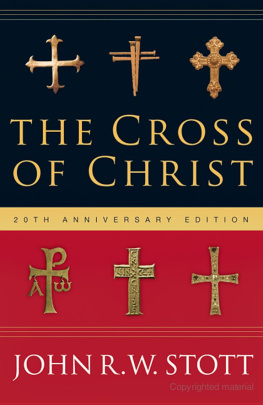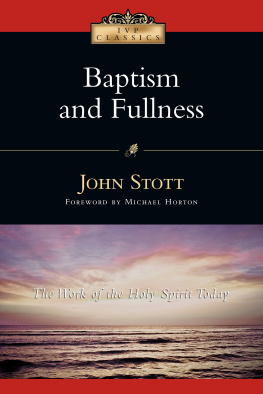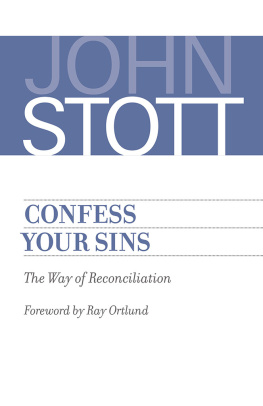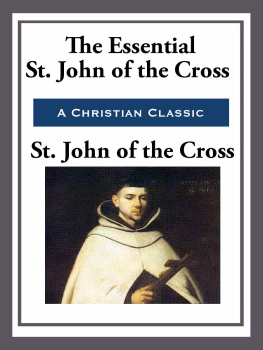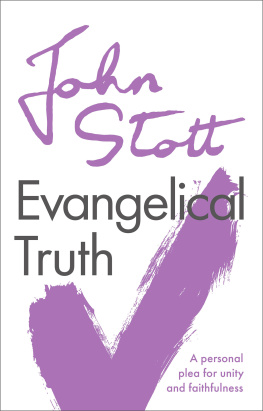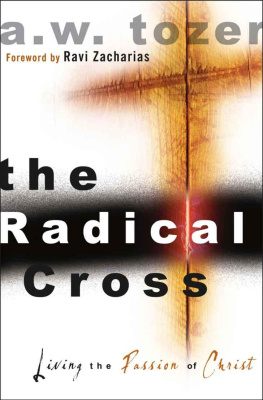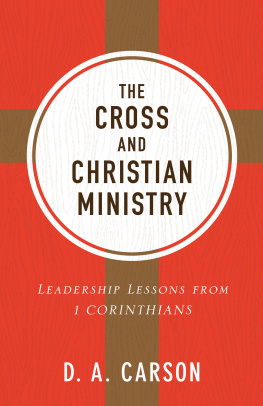The Cross of Christ
20th Anniversary
John R. W. Stott
Foreword by Alister McGrath

www.IVPress.com/books
Scripture
God forbid that I should boast of anything but the cross of our Lord Jesus Christ (Galatians 6:14, NEB )
InterVarsity Press
P.O. Box 1400
Downers Grove, IL 60515-1426
World Wide Web: www.ivpress.com
E-mail:
John R. W. Stott 1986, 2006
All rights reserved. No part of this book may be reproduced in any form without written permission from InterVarsity Press.
InterVarsity Press is the book-publishing division of InterVarsity Christian Fellowship/USA, a movement of students and faculty active on campus at hundreds of universities, colleges and schools of nursing in the United States of America, and a member movement of the International Fellowship of Evangelical Students. For information about local and regional activities, write Public Relations Dept. InterVarsity Christian Fellowship/USA, 6400 Schroeder Rd., P.O. Box 7895, Madison, WI 53707-7895, or visit the IVCF website at www.intervarsity.org .
All Scripture quotations, unless otherwise indicated, are taken from the Holy Bible, New International Version . NIV Copyright 1973, 1978, 1984 by International Bible Society. Used by permission of Hodder and Stoughton Ltd. All rights reserved. NIV is a registered trademark of International Bible Society. UK trademark number 1448790. Distributed in North America by permission of Zondervan Publishing House.
Cover design: Cindy Kiple
Cover image: Image source/Getty Images
Mike Bentley/iStockphoto
Lisa Ison/iStockphoto
Dan Farrall/Getty Images
fstop123/iStockphoto
cstar55/iStockphoto
ISBN 978-0-8308-6636-6
Contents
Foreword
In the twenty years since its publication, John Stotts The Cross of Christ has established itself as the most respected and authoritative evangelical writing on this most important of subjects. It remains the standard work on its great themes, inspiring, challenging, encouraging and informing its many readers. It is, in my view, John Stotts greatest and best work, written at the height of his career, when he was sixty-five years old. We see in its pages more of this great writers mind and heart than in any other of his many writings. It is as if he waited until he felt he was ready to write on so great a theme, enabling him to distil the theological precision, pastoral wisdom, and rhetorical gifts of a lifetime. If this is so, it was definitely worth waiting for.
Why is this book so important? At one level, its significance lies in its being the masterpiece of the Christian who is widely regarded as one of the greatest Christian writers, speakers, thinkers and leaders of the twentieth century. John Stott was born in 1921, the son of Sir Arnold Stott, a leading Harley Street physician, noted for his agnosticism as much as his medical skills. He was educated at Rugby School, where he became head boy. Although spiritually inquisitive, he could not at first find any meaningful association between faith and life. As he later recalled:
As a typical adolescent, I was aware of two things about myself, though doubtless I could not have articulated them in these terms then. First, if there was a God, I was estranged from him. I tried to find him, but he seemed to be enveloped in a fog I could not penetrate. Secondly, I was defeated. I knew the kind of person I was, and also the kind of person I longed to be. Between the ideal and the reality there was a great gulf fixed. I had high ideals but a weak will.
Yet this spiritual restlessness came to an end after John Stott heard Eric Nash give a talk to the Rugby School Christian Union in February 1938. As he recalls, what brought me to Christ was this sense of defeat and of estrangement, and the astonishing news that the historic Christ offered to meet the very needs of which I was conscious. As he later reflected on his conversion:
That night at my bedside I made the experiment of faith, and opened the door to Christ. I saw no flash of lightning...in fact I had no emotional experience at all. I just crept into bed and went to sleep. For weeks afterwards, even months, I was unsure what had happened to me. But gradually I grew, as the diary I was writing at the time makes clear, into a clearer understanding and a firmer assurance of the salvation and lordship of Jesus Christ.
John Stott went on to Cambridge University, taking first-class honours in modern languages, then, as he trained for ministry in the Church of England, in theology. In 1945, he became curate at the London church now firmly associated with his name and ministry All Souls, Langham Place. In a highly unusual move, John Stott was appointed rector of this church in 1950, and remained in this position for twenty-five years. During this time, All Souls became the centre of John Stotts dynamic ministry, including pioneering work involving guest services, student missions, and a punishing speaking schedule which took him all over the world.
So what gave such energy to this mission? What resource both propelled John Stott into this ministry, and sustained him throughout? To read this book is to find the answer. John Stott found and enables his readers to find the intellectual and spiritual riches of the cross that sustain the life of discipleship, especially in times of darkness and difficulty. John Stotts carefully calibrated analysis of the significance of the cross enables us to gain an appreciation of how the cross transforms everything, [giving] us a new, worshipping relationship to God, a new and balanced understanding of ourselves, a new incentive to give ourselves in mission, a new love for our enemies, and a new courage to face the perplexities of suffering. At point after point, readers of this book will realize how and why the cross stands at the centre of John Stotts faith and ministry.
John Stott would insist, however, that the importance of the book ultimately lies in the subject itself. There is no greater, no more challenging task for a Christian leader than to set out the meaning of the cross for the church and for the world. John Stotts masterly examination takes the form of four major sections: Approaching the Cross, The Heart of the Cross, The Achievement of the Cross and Living under the Cross. The first section offers a survey of Christian history, reflecting on the remarkable way in which the cross became the central theme and foundational image of the Christian faith.
For many readers, however, it is the second and third sections of the work that bring us to the heart of the gospel. In a bold yet careful investigation of the human situation, John Stott demonstrates our incapacity to change our own situation. We are sinners; and how can such sinners hope to stand in the presence of a holy and righteous God? How can we hope to gain access to such a God, when everything about our nature seems to stand in our way? John Stotts answer is classic in itself, and classic in its inspiration: a divine redeemer was needed, able to bring Gods salvation to the human situation. Neither Christ alone as man nor the Father alone as God could be our substitute. Only God in Christ, God the Fathers own and only Son made man, could take our place. The cross is the place at which God brings his salvation and revelation to sinful humanity. John Stotts exploration is marked by a clarity of biblical exposition and precision of theological dissection which few could hope to achieve. It is at present, as it has been for the last twenty years, the best and most persuasive account of the classic evangelical understanding of the meaning of the cross.
The final section of the work explores the relation between the cross and Christian discipleship in the church and world. We are called to abandon our supposed right to go on our own way, and come under the authority of the crucified Christ.
Next page
